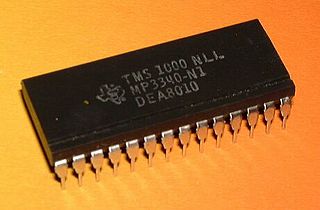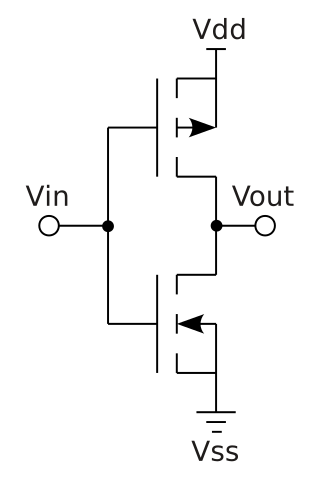Related Research Articles
European Strategic Programme on Research in Information Technology (ESPRIT) was a series of integrated programmes of information technology research and development projects and industrial technology transfer measures. It was a European Union initiative managed by the Directorate General for Industry of the European Commission.

An integrated circuit (IC), also known as a microchip, computer chip, or simply chip, is a small electronic device made up of multiple interconnected electronic components such as transistors, resistors, and capacitors. These components are etched onto a small piece of semiconductor material, usually silicon. Integrated circuits are used in a wide range of electronic devices, including computers, smartphones, and televisions, to perform various functions such as processing and storing information. They have greatly impacted the field of electronics by enabling device miniaturization and enhanced functionality.

A microprocessor is a computer processor for which the data processing logic and control is included on a single integrated circuit (IC), or a small number of ICs. The microprocessor contains the arithmetic, logic, and control circuitry required to perform the functions of a computer's central processing unit (CPU). The IC is capable of interpreting and executing program instructions and performing arithmetic operations. The microprocessor is a multipurpose, clock-driven, register-based, digital integrated circuit that accepts binary data as input, processes it according to instructions stored in its memory, and provides results as output. Microprocessors contain both combinational logic and sequential digital logic, and operate on numbers and symbols represented in the binary number system.

Complementary metal–oxide–semiconductor is a type of metal–oxide–semiconductor field-effect transistor (MOSFET) fabrication process that uses complementary and symmetrical pairs of p-type and n-type MOSFETs for logic functions. CMOS technology is used for constructing integrated circuit (IC) chips, including microprocessors, microcontrollers, memory chips, and other digital logic circuits. CMOS technology is also used for analog circuits such as image sensors, data converters, RF circuits, and highly integrated transceivers for many types of communication.
In computer engineering, a hardware description language (HDL) is a specialized computer language used to describe the structure and behavior of electronic circuits, most commonly to design ASICs and program FPGAs.

The Intel 4004 is a 4-bit central processing unit (CPU) released by Intel Corporation in 1971. Sold for US$60, it was the first commercially produced microprocessor, and the first in a long line of Intel CPUs.

Federico Faggin is an Italian-American physicist, engineer, inventor and entrepreneur. He is best known for designing the first commercial microprocessor, the Intel 4004. He led the 4004 (MCS-4) project and the design group during the first five years of Intel's microprocessor effort. Faggin also created, while working at Fairchild Semiconductor in 1968, the self-aligned MOS (metal-oxide-semiconductor) silicon-gate technology (SGT), which made possible MOS semiconductor memory chips, CCD image sensors, and the microprocessor. After the 4004, he led development of the Intel 8008 and 8080, using his SGT methodology for random logic chip design, which was essential to the creation of early Intel microprocessors. He was co-founder and CEO of Zilog, the first company solely dedicated to microprocessors, and led the development of the Zilog Z80 and Z8 processors. He was later the co-founder and CEO of Cygnet Technologies, and then Synaptics.

Richard "Dick" Francis Lyon is an American inventor, scientist, and engineer. He is one of the two people who independently invented the first optical mouse devices in 1980. He has worked in signal processing and was a co-founder of Foveon, Inc., a digital camera and image sensor company.
Neil H. E. Weste, is an Australian inventor and engineer, noted for having designed a 2-chip wireless LAN implementation and for authoring the textbook Principles of CMOS VLSI Design. He has worked in many aspects of integrated-circuit design and was a co-founder of Radiata Communications.
The Berkeley IRAM project was a 1996–2004 research project in the Computer Science Division of the University of California, Berkeley which explored computer architecture enabled by the wide bandwidth between memory and processor made possible when both are designed on the same integrated circuit (chip). Since it was envisioned that such a chip would consist primarily of random-access memory (RAM), with a smaller part needed for the central processing unit (CPU), the research team used the term "Intelligent RAM" to describe a chip with this architecture. Like the J–Machine project at MIT, the primary objective of the research was to avoid the Von Neumann bottleneck which occurs when the connection between memory and CPU is a relatively narrow memory bus between separate integrated circuits.
A semiconductor package is a metal, plastic, glass, or ceramic casing containing one or more discrete semiconductor devices or integrated circuits. Individual components are fabricated on semiconductor wafers before being diced into die, tested, and packaged. The package provides a means for connecting it to the external environment, such as printed circuit board, via leads such as lands, balls, or pins; and protection against threats such as mechanical impact, chemical contamination, and light exposure. Additionally, it helps dissipate heat produced by the device, with or without the aid of a heat spreader. There are thousands of package types in use. Some are defined by international, national, or industry standards, while others are particular to an individual manufacturer.
The Warp machines were a series of increasingly general-purpose systolic array processors, created by Carnegie Mellon University (CMU), in conjunction with industrial partners G.E., Honeywell and Intel, and funded by the U.S. Defense Advanced Research Projects Agency (DARPA).
Loquendo is an Italian multinational computer software technology corporation, headquartered in Torino, Italy, that provides speech recognition, speech synthesis, speaker verification and identification applications. Loquendo, which was founded in 2001 under the Telecom Italia Lab, also had offices in United Kingdom, Spain, Germany, France, and the United States.

Ian A. Young is an Intel engineer. Young is a co-author of 50 research papers, and has 71 patents in switched capacitor circuits, DRAM, SRAM, BiCMOS, x86 clocking, Photonics and spintronics.
Telecom Italia Lab S.p.A. is an Italian research center for telecommunication based in Torino, the biggest in Italy and one of the most important in Europe.
Alberto Ciaramella is an Italian computer engineer and scientist. He is notable for extensive pioneering contributions in the field of speech technologies and applied natural language processing, most of them at CSELT and Loquendo, with the amount of 40 papers and four patents.
Eloquens™ is a text-to-speech software, whose first version was released in 1993 by CSELT. It was the first commercial speech synthesis software able to speak Italian.

Nader Bagherzadeh is a professor of computer engineering in the Department of Electrical Engineering and Computer Science at the University of California, Irvine, where he served as a chair from 1998 to 2003. Bagherzadeh has been involved in research and development in the areas of: Computer Architecture, Reconfigurable Computing, VLSI Chip Design, Network-on-Chip, 3D chips, Sensor Networks, Computer Graphics, Memory and Embedded Systems. Bagherzadeh was named Fellow of the Institute of Electrical and Electronics Engineers (IEEE) in 2014 for contributions to the design and analysis of coarse-grained reconfigurable processor architectures. Bagherzadeh has published more than 400 articles in peer-reviewed journals and conferences. He was with AT&T Bell Labs from 1980 to 1984.

Multichannel Speaking Automaton (MUSA) was an early prototype of Speech Synthesis machine started in 1975.
References
- ↑ Cesare Mossotto (2011). "Centro studi e laboratori telecomunicazioni (CSELT)". In Cantoni, Virginio; Falciasecca, Gabriele; Pelosi, Giuseppe (eds.). Storia delle telecomunicazioni, Vol. 1 (in Italian). Firenze University Press. p. 394. ISBN 978-88-6453-243-1.
- ↑ Licciardi, L.; Paolini, M.; Tasso, R.; Torielli, A.; Cecinati, R. (May 1989). "RIPAC: A VLSI processor for speech recognition". 1989 Proceedings of the IEEE Custom Integrated Circuits Conference. pp. 20.6/1–20.6/4. doi: 10.1109/CICC.1989.56798 . S2CID 62563680.